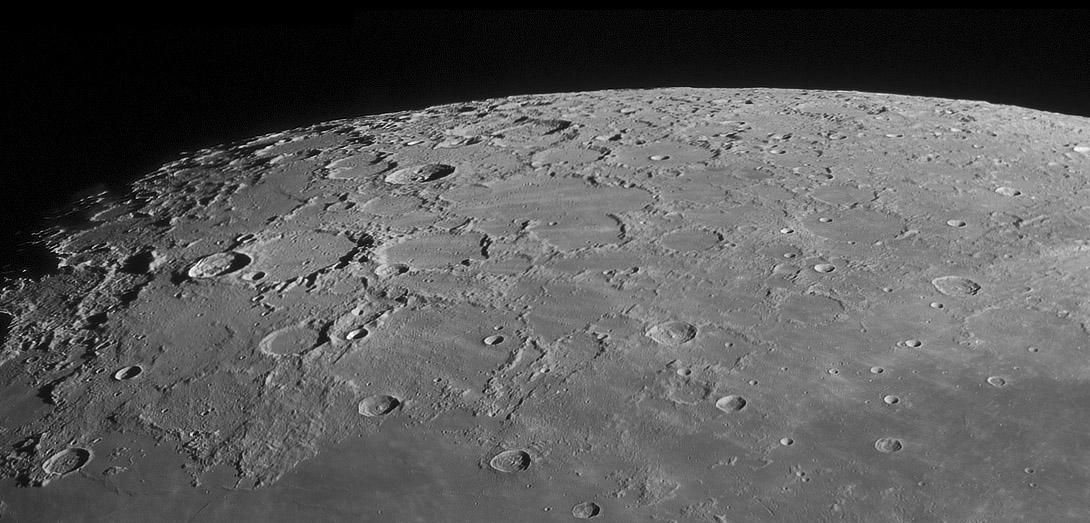Difference between revisions of "April 11, 2010"
| Line 5: | Line 5: | ||
<em>image by [mailto:dvmak@mail.ru Dmitry Makolkin], Moscow, Russia</em><br /> | <em>image by [mailto:dvmak@mail.ru Dmitry Makolkin], Moscow, Russia</em><br /> | ||
<br /> | <br /> | ||
| − | The lunar south polar region gets more attention than the north pole area because the topography is more dramatic. But, as this excerpt from Dmitry's [http://www.makolkin.ru/Gallery/100325/Moon_100325_TAL-250K_DMK31.html mosaic] illustrates, there are interesting topo details in the north too. The basic character of the landscape is different - it is flatter because most of the craters are partially filled with basin ejecta from Imbrium. Only a few post-Imbrium craters are conspicuous, including Scoresby (center top) and Anaxagoras (left) with rays radiating away to the east. When I am observing this area I get my bearings using the distinctive conjoined twins Challis and Main, just poleward of Scoresby. Despite the north pole's lack of large permanently shadowed craters there appears to be much [ | + | The lunar south polar region gets more attention than the north pole area because the topography is more dramatic. But, as this excerpt from Dmitry's [http://www.makolkin.ru/Gallery/100325/Moon_100325_TAL-250K_DMK31.html mosaic] illustrates, there are interesting topo details in the north too. The basic character of the landscape is different - it is flatter because most of the craters are partially filled with basin ejecta from Imbrium. Only a few post-Imbrium craters are conspicuous, including Scoresby (center top) and Anaxagoras (left) with rays radiating away to the east. When I am observing this area I get my bearings using the distinctive conjoined twins Challis and Main, just poleward of Scoresby. Despite the north pole's lack of large permanently shadowed craters there appears to be much [[March_2,_2010|more ice]] there than in the more visually dramatic opposite pole.<br /> |
<br /> | <br /> | ||
<em>[mailto:tychocrater@yahoo.com Chuck Wood]</em><br /> | <em>[mailto:tychocrater@yahoo.com Chuck Wood]</em><br /> | ||
| Line 16: | Line 16: | ||
History note: Apollo 13 was launched toward the Moon 40 years ago today - a failed mission and one of NASA's greatest triumphs.<br /> | History note: Apollo 13 was launched toward the Moon 40 years ago today - a failed mission and one of NASA's greatest triumphs.<br /> | ||
<br /> | <br /> | ||
| + | <p><b>Yesterday's LPOD:</b> [[April 10, 2010|Farewell To the Commander]] </p> | ||
| + | <p><b>Tomorrow's LPOD:</b> [[April 12, 2010|Wobble Analglyph]] </p> | ||
<hr /> | <hr /> | ||
Revision as of 11:20, 7 February 2015
Polar Pastime

image by Dmitry Makolkin, Moscow, Russia
The lunar south polar region gets more attention than the north pole area because the topography is more dramatic. But, as this excerpt from Dmitry's mosaic illustrates, there are interesting topo details in the north too. The basic character of the landscape is different - it is flatter because most of the craters are partially filled with basin ejecta from Imbrium. Only a few post-Imbrium craters are conspicuous, including Scoresby (center top) and Anaxagoras (left) with rays radiating away to the east. When I am observing this area I get my bearings using the distinctive conjoined twins Challis and Main, just poleward of Scoresby. Despite the north pole's lack of large permanently shadowed craters there appears to be much more ice there than in the more visually dramatic opposite pole.
Chuck Wood
Technical Details
Mar 25, 2010. TAL-250K + DMK 31AU03.AS + Astronomics IR ro 743nm filter. Registax 5.1beta, 350/2500 frames.
Related Links
Rükl plate 4
History note: Apollo 13 was launched toward the Moon 40 years ago today - a failed mission and one of NASA's greatest triumphs.
Yesterday's LPOD: Farewell To the Commander
Tomorrow's LPOD: Wobble Analglyph



